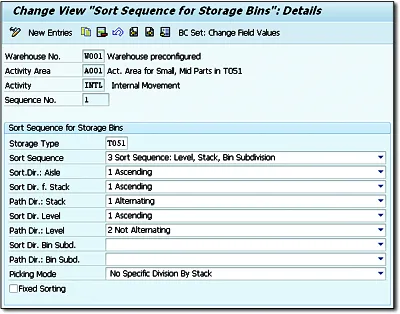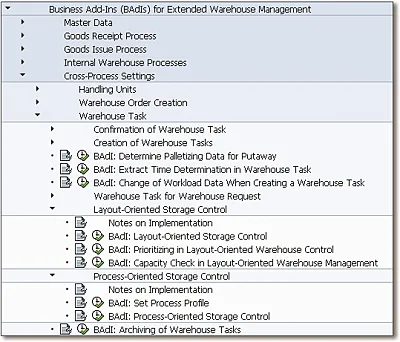
eBook - ePub
SAP EWM Architecture and Programming
Peter Zoellner, Robert Halm, Daniela Schapler, Karen Schulze
This is a test
Condividi libro
- 494 pagine
- English
- ePUB (disponibile sull'app)
- Disponibile su iOS e Android
eBook - ePub
SAP EWM Architecture and Programming
Peter Zoellner, Robert Halm, Daniela Schapler, Karen Schulze
Dettagli del libro
Anteprima del libro
Indice dei contenuti
Citazioni
Domande frequenti
Come faccio ad annullare l'abbonamento?
È semplicissimo: basta accedere alla sezione Account nelle Impostazioni e cliccare su "Annulla abbonamento". Dopo la cancellazione, l'abbonamento rimarrà attivo per il periodo rimanente già pagato. Per maggiori informazioni, clicca qui
È possibile scaricare libri? Se sì, come?
Al momento è possibile scaricare tramite l'app tutti i nostri libri ePub mobile-friendly. Anche la maggior parte dei nostri PDF è scaricabile e stiamo lavorando per rendere disponibile quanto prima il download di tutti gli altri file. Per maggiori informazioni, clicca qui
Che differenza c'è tra i piani?
Entrambi i piani ti danno accesso illimitato alla libreria e a tutte le funzionalità di Perlego. Le uniche differenze sono il prezzo e il periodo di abbonamento: con il piano annuale risparmierai circa il 30% rispetto a 12 rate con quello mensile.
Cos'è Perlego?
Perlego è un servizio di abbonamento a testi accademici, che ti permette di accedere a un'intera libreria online a un prezzo inferiore rispetto a quello che pagheresti per acquistare un singolo libro al mese. Con oltre 1 milione di testi suddivisi in più di 1.000 categorie, troverai sicuramente ciò che fa per te! Per maggiori informazioni, clicca qui.
Perlego supporta la sintesi vocale?
Cerca l'icona Sintesi vocale nel prossimo libro che leggerai per verificare se è possibile riprodurre l'audio. Questo strumento permette di leggere il testo a voce alta, evidenziandolo man mano che la lettura procede. Puoi aumentare o diminuire la velocità della sintesi vocale, oppure sospendere la riproduzione. Per maggiori informazioni, clicca qui.
SAP EWM Architecture and Programming è disponibile online in formato PDF/ePub?
Sì, puoi accedere a SAP EWM Architecture and Programming di Peter Zoellner, Robert Halm, Daniela Schapler, Karen Schulze in formato PDF e/o ePub, così come ad altri libri molto apprezzati nelle sezioni relative a Informatique e Sciences générales de l'informatique. Scopri oltre 1 milione di libri disponibili nel nostro catalogo.
Informazioni
No warehouse is like any other; the diversity of stored goods and warehouse sites make for some challenges when it comes to warehouse management with standardized software. This chapter discusses how SAP EWM offers flexibility to meet specific warehousing requirements.
1Flexible Warehouse Management with Extended Warehouse Management
In addition to the general configurability of SAP software, customers frequently make use of its extensibility. This is why a variety of software and consulting firms specialize in the enhancement of SAP software and customers also maintain in-house development departments.
Every day, thousands of people exchange information within SAP's own public developer platform, the SAP Community Network (SCN), regarding tips and tricks for developing with SAP software. In this book, we support customers, consultants, and developers in enhancing SAP EWM, because our project experience shows us that SAP software extensibility is vividly used in implementation projects of warehouse management solutions.
In the following sections, we examine the reasons for this and give an overview of the extensibility of SAP EWM. Next to the various deployment options of SAP EWM in the system landscape, integration with other SAP and non-SAP software products, as well as the configuration of the warehouse organizational structure and process flows, it is the especially high enhancement capability of SAP EWM that ensures software flexibility and adaptability during implementation and operation.
1.1Warehouse Management with Standardized Software: Configuration and Enhancement
Using standardized software when it comes to managing a warehouse with large functional scope will depend on the adaptability of the application simply because no warehouse is identical to another in regards to layout and operation. The need for configurability of the software mainly stems from the uniqueness of warehouses concerning:
- Physical layout
- Availability of storage space: capacity utilization
- Nature of products: storage concepts
- Degree of automation
It should be noted that storage requirements may frequently change over a warehouse’s lifetime. These changes might occur with the introduction of new products or strategic realignment of supply chains and may result in new creation or conversion of storage areas. As a change to the physical layout may be costly, time consuming, and bring along a temporary loss of storage space, change capabilities of a warehousing software application are often called for, not only to adapt to new physical conditions but also to avoid physical adaptation efforts.
Such detailed customer requirements are difficult to predict and can no longer be anticipated in the context of configurability. This is where the focus turns from configuration to enhancement options of the application.
Under these conditions, the architect of standard software needs to identify the basic requirements and functionality. Keeping track of potential variations is a key element of standard software design, as is incorporating corresponding configuration and enhancement options.
Regarding the flexibility of the software, we understand the capability of the application to adapt to customer requirements. Ultimately this flexibility might be measured by the number of existing configuration and enhancement options. In the next section, we would like to talk about these options for SAP EWM.
1.2Flexibility of Extended Warehouse Management
So what is the answer from SAP to the previously identified need for flexibility of software solutions for warehouse management? In this section, we highlight some examples of the configurability and extensibility of SAP EWM.
We chose the following examples of configuration and enhancement options because we wanted to highlight two new functionalities of SAP EWM that were not available in LES-WM. First, we will look at activity areas as new elements of the warehouse organizational structure and second, we will turn toward the modeling of multistep warehouse processes by the means of the storage control.
1.2.1Activity Areas: Flexible Assignment of Storage Bins to Work Areas for Warehouse Operators
SAP EWM allows for the grouping of storage bins for a particular activity, such as putaway or picking. Such groups are called activity areas. The grouping of storage bins to activity areas can be done regardless of the bins’ storage type or storage area assignment and is also not limited to other storage bin characteristics.
After completing activity area setup and bin assignment, the bins belonging to certain activity areas are sorted by configurable criteria. This bin sorting will be applied for the sequencing of warehouse tasks within a warehouse order.
The available customization of activity areas includes the configuration option of relevant parameters concerning the warehouse operation:
- Activities (definition and determination)
- Activity areas (definition and assignment of bins)
- Sort sequences (bin sorting rule within an activity area)
Figure 1.1 shows the available customizing transactions for the configuration of activity areas.

Figure 1.1Customizing of Activity Areas
The sorting of storage bins within an activity area is of great importance, because it ultimately controls the paths and distances that need to be traveled by the operators in the warehouse while executing movement activities as well as the utilization of storage bins. SAP EWM provides configuration options for the sorting logic that controls the sort order, as shown in the example in Figure 1.2.

Figure 1.2Customizing of Sort Sequences
The configuration options available should already perfectly meet the sorting requirements of many warehouses. Should they be insufficient, a program for uploading sorting data from external sources and a BAdI by which a custom sorting logic can be implemented are also available. You can find the BAdI in the IMG (Implementation Guide) on the path Business Add-Ins (BAdIs) for Extended Warehouse Management • Master Data • Activity Areas • BAdI: Define Sort Sequence of Activity Areas. The BAdI allows you to change the bin sorting that has been determined according to the configuration criteria. The sorting is made available as a data input parameter and allows for being adapted inside the BAdI. This way you can flexibly enhance or overrule the configuration options provided by implementing and activating the BAdI.
1.2.2Storage Control: Modeling Multistep Warehouse Processes
The second example to illustrate SAP EWM’s flexibility of configuration and enhancement takes us to the functionality of the storage control. This can be differentiated into layout-oriented or process-oriented storage control where both can be used simultaneously. By using storage control, you can, for example, define the additional activities that should be carried out for certain products or movements before putting away the stock. This activity can be modeled as a work step and be determined as part of a warehouse process flow.
When configured as such, SAP EWM will create a warehouse task to move the stock from the receiving zone into the work center at the time that the goods receipt has been completed. The confirmation of this task will automatically generate the follow-up warehouse task for putaway. For this to work, the stock must actually be contained in a handling unit, since the handling unit keeps track of the progress within the process flow by holding the current process step. The respective steps in the process can be modeled in a flexible way and be combined with layout-oriented routing. As an example, you can configure things so that, on the way from the receiving zone to the work center, stock has to be handed over between resources of different resource types. This way you can have the system control the warehouse activities to a great extent and increase the visibility of inventory at any time. Similarly, as in the example of the activity areas, the storage control functionality can be set up by configuration options. Figure 1.3 and Figure 1.4 show the respective customizing transactions for layout-oriented and process-oriented storage control, which allow for a high degree of flexibility even when configuring more complex process flows.

Figure 1.3Configuration of Layout-Oriented Storage Control

Figure 1.4Configuration of Process-Oriented Storage Control
Now, however, it may happen that you have a requirement that cannot be covered by means of configuration alone. Let’s say you want to suspend an intermediate location of the layout-oriented setup or skip a process-oriented step in certain situations or for certain products. For this purpose, once again BAdIs are available that allow you to individually tailor a solution logic to the particular requirements of storage control, as shown in Figure 1.5.

Figure 1.5Enhancement Options for Storage Control
1.3Summary
SAP EWM indeed offers a variety of additional functionality that is configurable and expandable in a similar manner. Ultimately there are more than six hundred customizing tables and five hundred BAdIs availab...